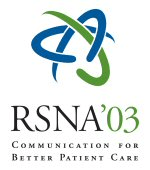
Abstract Archives of the RSNA, 2003
A23-197
Isolated Teres Minor Atrophy on MR Imaging: Quadrilateral Space Syndrome or Result of Rotator Cuff Pathology?
Scientific Papers
Presented on November 30, 2003
Presented as part of A23: Musculoskeletal (Imaging of the Shoulder)
Michael Recht MD, PRESENTER: Nothing to Disclose
Abstract:
HTML
Purpose: The finding of isolated TM atrophy on MRI has usually been attributed to quadrilateral space syndrome (QSS), an unusual clinical syndrome seen in adults between 22 and 35 years of age. QSS is caused by compression of the posterior humeral circumflex artery and axillary nerve in the quadrilateral space. Symptoms include paresthesias, pain, quadrilateral space point tenderness, and atrophy of the teres minor(TM) and deltoid muscles. However, multiple cases of isolated TM atrophy on MRI in patients who do not fit the expected age range nor have the typical clinical symptoms of QSS have been seen in our institution. Therefore, a prospective study was performed to determine the incidence, age distribution and associated findings of isolated TM atrophy on shoulder MRI.
Methods and Materials: A prospective study of 217 shoulder MRI was performed over 3 months. All studies were interpreted by 1 of 3 musculoskeletal radiologists and graded for: age, gender, atrophy of the rotator cuff and deltoid muscles, presence, location and size of rotator cuff tears, presence and location of labral tears and paralabral cysts, and the presence of a quadrilateral space mass. The presence of atrophy within the muscles was graded on a 5-point scale (no fat, fat streaks, fat < muscle, fat = muscle, fat > muscle). Isolated TM atrophy was considered present when fat was equal to or greater than muscle in the TM muscle only. Clinical symptoms were also recorded.
Results: There were 12 cases of isolated TM atrophy (5.5%). No cases had deltoid atrophy. Average age was 60 years (26-83) with 3 patients under 50 years of age. 11 patients were males. 10 patients had rotator cuff tears, 1 (age 26) had an isolated posterior labral tear and one (age 32) had no associated pathology. 9 of the 10 cuff tears were full thickness and there was 1 high-grade partial thickness tear. There were 5 isolated supraspinatus tears, 1 isolated infraspinatus tear, and 4 tears involved 2 muscles. No patients had quadrilateral space masses. 11 patients presented with pain with no history of paresthesias or quadrilateral space point tenderness. 1 patient (posterior labral tear) presented with instability.
Conclusion: Isolated TM atrophy on MRI is most commonly seen in patients who do not fit the expected age range or clinical presentation of QSS. Therefore it seems unlikely that these patients have QSS. The etiology of the TM atrophy is uncertain but the frequent presence of rotator cuff tears in these patients raises the possibility of an association between cuff dysfunction and TM atrophy.
Questions about this event email: rechtm@ccf.org
Recht MD, M,
Isolated Teres Minor Atrophy on MR Imaging: Quadrilateral Space Syndrome or Result of Rotator Cuff Pathology?. Radiological Society of North America 2003 Scientific Assembly and Annual Meeting, November 30 - December 5, 2003 ,Chicago IL.
http://archive.rsna.org/2003/3105406.html

